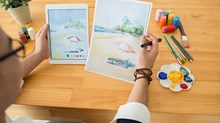Ready to Go?
Toilet training is a milestone right up there with first words and first steps. But it's also a time-sensitive undertaking. When a toddler displays an interest in using the potty and experiences a few successes, it's tempting for parents to get so excited that they rush the process. A willingness to use the toilet is just one of the signs of readiness parents can look for as they venture down this road. Parent and educator Jan Faull, author of Mommy I Have to Go Potty: A Parent's Guide to Toilet Training (Raefield-Roberts) suggests some guidelines to see if your child is ready, willing, and able to be potty-trained:
? How old is your child? According to Faull, most attempts to train a child under 2 will result in failure and frustration.
? How long can he stay dry? A child is physically ready for toilet training when his diaper is dry for an hour and a half at a time, indicating that his bladder muscles have developed to the point where he can learn some control.
? How aware is your child of his bladder and bowel functions? If he stops playing while having a bowel movement, he is aware that something different is going on. He might also mention that his diaper is wet or dirty or acknowledge that he is in the process of going potty.
? How interested is your child? If your child will sit on the toilet to practice and is interested in wearing underwear, he's probably ready to give up diapers and is emotionally mature enough to toilet train.
Once your child is ready, you can start the toilet-training process. Be patient and understanding, knowing that your little one is as excited to take this step as you are. Give it time and before you know it, the diaper days will be over.
?Sandra Byrd, writer, mother of two
Toys That Build Independence
Your toddler's ability to play alone is not only a chance for you to turn your attention to something else for a few minutes, it's also an important developmental phase for her. To encourage independent play in your toddler, try these toys:
? Play Clay: Toddlers can create cakes, snakes, space ships, flowers, critters, and more. Offer your child a lump of non-toxic, non-staining clay to play with while you make supper or finish a project. Keep a plastic bin handy that's filled with clay (in air-tight containers to keep it from drying out), a miniature rolling pin, small plastic cookie cutters, jar lids, and other safe items that make fun impressions in clay.
? Mimicking Toys: If you're in the yard, give your toddler a play watering can or plastic shovel to use in her own patch of dirt; when you're baking cookies, provide "batter" (just mix up some flour and water), a bowl, and a fork and ask your child to get the lumps out; If you're paying bills, get your toddler involved with her own play calculator, envelopes, paper, and pen.
? Books: Visit the library regularly and replenish your book shelves with seasonal picture books. Invite your toddler to color pictures for her own "book." Later, ask her to tell you about her pictures and write down what she says to make the text of the book.
? Chalk: Driveways and sidewalks are a blank canvas ready to be beautified. Help your child draw a big map of your block or town in chalk. Include places you go together, like the grocery store, the library, and your church. Let him run toy cars along the streets, stopping at his favorite places along the way.
?Karen Dockrey author, mother of two.
Copyright © 2001 by the author or Christianity Today/Christian Parenting Today Magazine.
Click here for reprint information on Christian Parenting Today.
Read more articles that highlight writing by Christian women at ChristianityToday.com/Women
 Read These Next
Read These Next
 The Art of ConcentrationYour guide to the ages and stages of development
The Art of ConcentrationYour guide to the ages and stages of development Worship WigglebustersFive games to keep children attentive in church
Worship WigglebustersFive games to keep children attentive in church
 Why Do We Compare Our Stories?Getting real about our struggles (even if another’s pain seems “worse”)
Why Do We Compare Our Stories?Getting real about our struggles (even if another’s pain seems “worse”)








 Homepage
Homepage